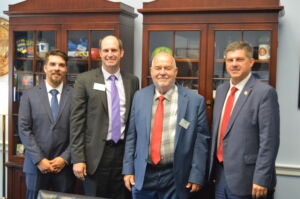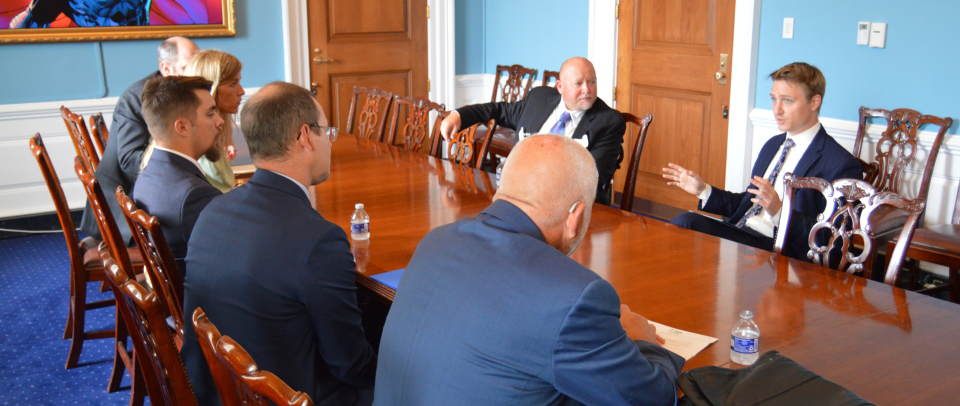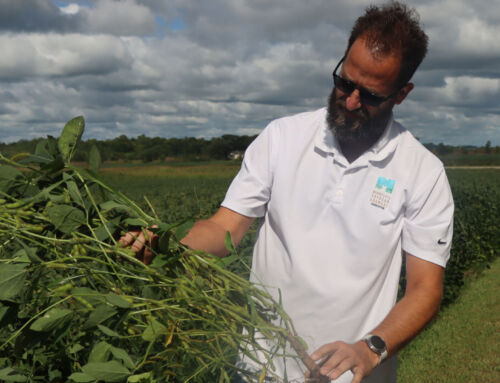A unique blend of veteran Minnesota soybean advocates and fresh faces traveled in July 2025 to Washington, D.C., for the American Soybean Association’s (ASA) summer Hill Visits.
Some of Minnesota’s farmer leaders, like George Goblish and Bob Worth, walked around the halls and chambers of the House and Senate buildings with a familiar ease. But for others, like Raymond DeMars and Rebecca Sip, who both represented Minnesota as last year’s class of the ASA Young Leaders, Capitol Hill gave them a chance to learn from the best and get their toes wet advocating on behalf of Minnesota’s nearly 26,000 soybean farmers. Farmer leaders were also joined by Executive Director Joe Smentek, who’s also no stranger to D.C. after 12 years with MSGA.
Heading into this year’s summer Hill Visits was unique. Just a couple weeks before the Hill Visits, many of ASA’s top policy priorities, including extending 45z tax credit through 2029 to support the biodiesel industry, updating the soybean reference price, increasing funding for trade development programs and improving Agriculture Risk Protection (ARP) and Price Loss Coverage (PLC) to protect farmers, had been signed into legislation as part of the “One Big Beautiful Bill.”
However, unfinished business remained to stabilize the farm economy. An extension of the Farm Bill is still on the table, and soybean farmers continue to hold concerns over the Make America Healthy Again Commission’s report that could jeopardize the soybean oil industry and remove input options for farmers.
“We’ve been talking about getting this Farm Bill to the finish line for about three and half years now, so we’ve had a lot of discussions about what we call Farm Bill 2.0, or what legislators are calling the ‘skinny farm bill,’ said Wells farmer Darin Johnson, who entered his second term as Minnesota Soybean Growers Association (MSGA) president earlier this summer.
MSGA leaders urged lawmakers on Capitol Hill to pass a comprehensive five-year Farm Bill that would protect investments in conservation, reinstate “orphan programs” for biofuels and biobased product research and development and protect the soybean checkoff that continues to support the long-term success of the nation’s half-million soybean farmers.
“If it wasn’t for the soybean checkoff, I wouldn’t be farming here if it wasn’t for investments that they made,” said Jim Kukowski, an ASA director who farms in Minnesota’s far north Roseau County. “We need to keep the checkoff alive and thriving.”
If a new Farm Bill is not passed or extended, many critical farm programs will revert back to permanent law that dates back to the 1930s and 1940s. Kukowski shared with legislators during the visits that a strong Farm Bill means a strong ag economy and stabilizes national security.
“The farm economy is the backbone of the U.S. economy, if it struggles so does everything else,” Kukowski said.
Trade certainty
Strengthening trade and eliminating tariffs were other key priorities for farmer leaders. More than half of the country’s soybean crop is exported, and is also Minnesota’s top ag export, valued at over $2 billion annually in the state alone. New tariffs with many of U.S. soy’s largest trading partners, including Mexico and Canada, are set to begin Aug. 1, which could have a reciprocating effect on the countries that import soybean from the U.S.

MSGA directors visit with one of their own, Brown County farmer Brad Finstad, who represents Minnesota’s First District.
“Tariffs have a direct impact on our pocketbook, which is already getting hit due to rising input costs,” said ASA Director Jeff Sorenson from Morgan, who hosted Sen. Tina Smith on his farm in April and spoke extensively with the senator on the importance of trade to the farm economy.
While tariff rates on China, the largest importer of U.S. soy (valued at over $13 billion annually, more than all other export markets combined), are nearly as high as they were during the 2018 trade war, District 1 Representative Brad Finstad believes things may settle down on the trade front.
“It’s my hope that we could see some certainty on the trade front soon,” said Congress man Finstad, who serves on the House Ag Committee and farms in Brown County. “I also want to give credit to the soybean industry for doing a good job in diversifying their markets.”
George of the Hill
For ASA Director George Goblish, the July 2025 Hill Visits came with mixed emotions. The Vesta farmer, who served as MSGA president from 2013-2015, returned to D.C. for his final Hill Visit since first becoming involved with MSGA over 15 years ago. Goblish, who has served on ASA’s executive committee and chaired the Commodity Classic Planning Committee, is terming off the ASA board in December after 12 years on the board. From his first visit to his last, Goblish notes that the political climate has changed, which he chalked up to less engagement among lawmakers in relaxed settings – the lunch room, for example.
“Back when I started, all the legislators, if they didn’t get their work done, they would gather in the cafeteria at night and have supper together, but now they close the cafeteria, so they go their own separate ways and don’t get to know each other,” Goblish said. “I think that has a lot to do with them struggling to build relationships with each other.”
But the more things change, the more they stay the same. Goblish says they continue to fight for the same things now as they did when he first started.
“We’re still working hard to promote biodiesel, just in greater volumes now, and we’re still working hard to promote a robust farm bill,” he said “but I think now the one big difference is the focus towards conservation.”
Goblish said his favorite part of the Hill Visits has been witnessing the hard work pay off and proving that spending time at the Capitol and building relationships with lawmakers results in effective advocacy
“There’s a little reward in seeing what we come out here and lobby for actually getting passed, which doesn’t happen overnight, but the ‘Big Beautiful Bill’ had a lot of our ASA priorities in it, and it meant a lot to see something go right for us,” he said.
As Goblish hops off one board, he steps on to another. He was recently elected to the Minnesota Soybean Research & Promotion Council and, pending USDA approval, is slated to serve on the national checkoff board, the United Soybean Board, in December 2025.
“It was a little bittersweet as I move on to other things, but I’m certainly going to miss the visits at the Capitol,” said Goblish.
And while Goblish is a familiar face in Washington, D.C., a pair of young MSGA directorsr are having their first chances to make an impact during Hill Visits. Recent ASA Corteva Young Leaders Program graduates Sip, who serves as the Norman County Director on MSGA, and DeMars from Morrison County, who serves on an at-large seat on MSGA, took part in their first-ever Hill Visit. The two emerging farmers took the opportunity to build relationships, learn about the process, endure a little ribbing from colleagues and tell their story.
“My time with the Young Leader Program really gave me the confidence to share what’s important to me and how to be impactful,” said DeMars. “I was really fortunate to be paired up with some veteran MSGA and ASA leaders who could show me the ropes around these visits.”
Thankfully on both sides of the aisle for the Minnesota delegation, including a face-to-face meeting with Sen. Amy Klobuchar, the talks around agriculture and soybeans were mostly positive. MSGA President Darin Johnson says Minnesota, which has strong representation on both the House and Senate Agriculture committees, continues to be a champion for agriculture.
“Our lawmakers do show a lot of interest in agriculture and ask a lot of genuine questions,” Johnson said. “I love being able to talk and educate them about what we do and how we do it on our farm.”







Leave A Comment